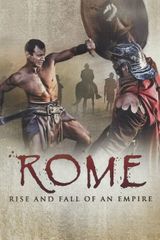
Rome: Rise and Fall of an Empire 1
2008-09-30 | War & Politics,Documentary | 13 episodes1 Season
Episode
The First Barbarian War (2008)
It is 113 BC Rome is a Republic, a small empire that clings to the rim of the Mediterranean. Though a democracy in name and spirit, a man must be rich and from the noble class to hold the highest offices, both political and military. The system has worked well for three centuries. But now a barbarian horde known as the Cimbri smashes through the northern imperial border. One humiliating defeat follows another, with losses of hundreds of thousands of Roman legionaries. Terror grips Rome and drives her into the arms of General Marius. Though he is a commoner, he has a brilliant military mind. To defeat the Cimbri, Marius will transform the Roman army and shake the Republic's political foundations to the core. It is a turning point for the Republic. Faced with the savage Cimbri, Rome must decide between dictatorship or annihilation.

Spartacus (2008)
When Roman generals Pompey and Crassus lead their mighty legions of soldiers and mercenaries into the lands surrounding Italy, neither could anticipate the turmoil caused by one bold mercenary: Spartacus. A Thracian warrior, Spartacus deserts the Roman army, but is captured and made a slave, forced to fight as a gladiator. But in 73 BC the untamable barbarian leads a slave revolt of 70,000 gladiators against the Roman Republic. Though the brutal and conniving Roman General Crassus is finally able to suppress the revolt, his rival, the more popular Pompey, takes all the credit, sparking a division within the Republic itself that will ultimately spell its demise.

Julius Caesar (2008)
It is 60 BC. Over-powerful generals and money corrupts the Roman Republic. The empire churns with civil war, and violence and murder run rampant in the streets. Julius Caesar, desperate for fame and honor, embarks on a brutal decade long campaign to annex Gaul and build his own reputation. His aristocratic rivals try to stop him, but he is an expert manipulator. His propaganda and extravagant victories against bloodthirsty barbarians thrill the public. In 49 BC, he crosses the Rubicon intending to claim his rightful place as the chief man of Rome. It sparks a new civil war that pits him against Pompey the Great and sounds the final death knell for the Republic.

The Forest of Death (2008)
As the Roman Empire expands its reaches into what is now Germany, its legions are faced with ferocious Germanic tribesmen. In 9 AD, their chieftain, Arminius, raised in Rome as a hostage of peace, uses his Roman military training to slaughter the Roman General Varus' army at Teutoburg Forest. This landmark battle establishes the Rhine River as the frontier between the Empire and its growing barbaric enemies. Six years later, when General Germanicus sets out across the Rhine for revenge, he finds heaps of bones and severed skulls nailed to trees - a reminder of the barbarians' victory. But at the Battle of the Weser River, he faces Arminius and wins. Germanicus captures Arminius' pregnant wife, Thusnelda, and parades her through the streets of Rome, as a symbol of his triumph.

The Invasion of Britain (2008)
It is 47 AD. The new emperor Claudius has lost the respect of those he seeks to rule. He can only hang onto his throne by waging a spectacular conquest. He chooses Britannia, a legendary land which fascinates and inspires fear in the Romans. Proud and warlike, the Britons use the island's treacherous terrain and dark forests to lure the legions to ruin. Led by magic wielding Druid priests and a charismatic warrior named Caratacus, the Britons resist in the face of the greatest military machine the world has ever known.

Photo
